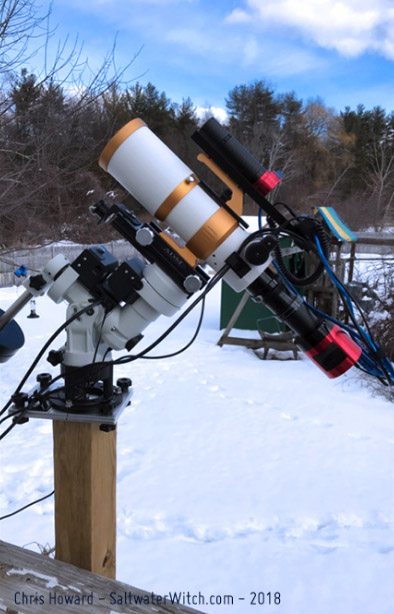Astro Session - March 11, 2018
March 11, 2018
 First test shots of M42, the Orion Nebula, M43 De Mairan’s Nebula, Sh2-279 Running Man with the ZWO ASI071MC cooled CMOS camera. No calibration frames, just 17 stacked 300 second light frames, with the sensor cooled to -10C. Last night was not very clear, scattered clouds, fairly poor seeing. I can't wait to test things out with some really clear and dark skies. I definitely need cal frames, because things ended up pretty noisy after processing. I will say, so far, with only a few hours of use, I'm impressed with this ZWO color camera. That doesn't surprise me. ZWO makes a solid camera--I've been using an ASI120MM-S for several years, as my guide camera. It's fast--USB 3, with a small but very sensitive monochrome sensor, and it just always works under any OS on a variety of hardware--Windows, Linux, MacOS. That's what I meant--it shouldn't surprise me that the ASI071MC (quite a bit more expensive and a far more capable camera) just works well. What did surprise me is how much this camera can pick up, bringing out some very faint nebulous areas. I know it has a very wide/high dynamic range. That's one of the things I was looking for in an OSC camera. For this M42 test I used a Gain of 0 and Offset of 8, the minimum recommended by ZWO for long exposure times and HDR (high dynamic range). We'll see how things go on the next clear night. I'd like to test out unity gain settings, and LRN (Lowest read noise) setting, which is high gain, high offset, used for short exposures. (William Optics GT-81 + 0.8x Field Flattener/Reducer f/4.7, ZWO ASI071MC cooled CMOS camera, iOptron CEM25P EQ mount, 30mm mini guide scope with ZWO ASI120MM-S guide cam, INDI/KStars/Ekos observatory control. Location: Stratham, New Hampshire, US. Bortle ~4). Astrobin
First test shots of M42, the Orion Nebula, M43 De Mairan’s Nebula, Sh2-279 Running Man with the ZWO ASI071MC cooled CMOS camera. No calibration frames, just 17 stacked 300 second light frames, with the sensor cooled to -10C. Last night was not very clear, scattered clouds, fairly poor seeing. I can't wait to test things out with some really clear and dark skies. I definitely need cal frames, because things ended up pretty noisy after processing. I will say, so far, with only a few hours of use, I'm impressed with this ZWO color camera. That doesn't surprise me. ZWO makes a solid camera--I've been using an ASI120MM-S for several years, as my guide camera. It's fast--USB 3, with a small but very sensitive monochrome sensor, and it just always works under any OS on a variety of hardware--Windows, Linux, MacOS. That's what I meant--it shouldn't surprise me that the ASI071MC (quite a bit more expensive and a far more capable camera) just works well. What did surprise me is how much this camera can pick up, bringing out some very faint nebulous areas. I know it has a very wide/high dynamic range. That's one of the things I was looking for in an OSC camera. For this M42 test I used a Gain of 0 and Offset of 8, the minimum recommended by ZWO for long exposure times and HDR (high dynamic range). We'll see how things go on the next clear night. I'd like to test out unity gain settings, and LRN (Lowest read noise) setting, which is high gain, high offset, used for short exposures. (William Optics GT-81 + 0.8x Field Flattener/Reducer f/4.7, ZWO ASI071MC cooled CMOS camera, iOptron CEM25P EQ mount, 30mm mini guide scope with ZWO ASI120MM-S guide cam, INDI/KStars/Ekos observatory control. Location: Stratham, New Hampshire, US. Bortle ~4). Astrobin

